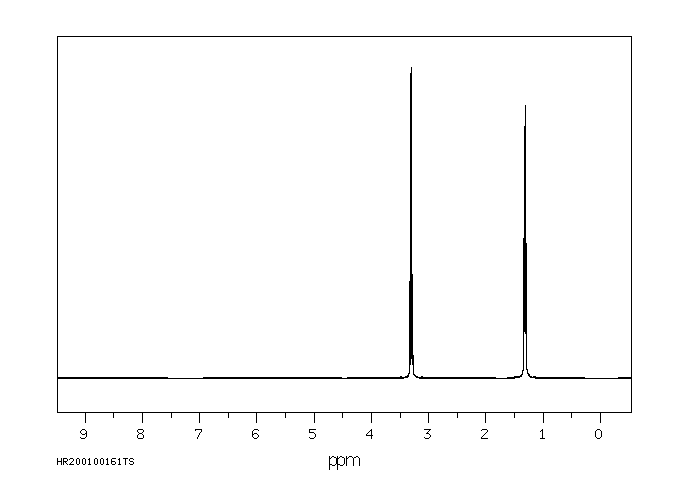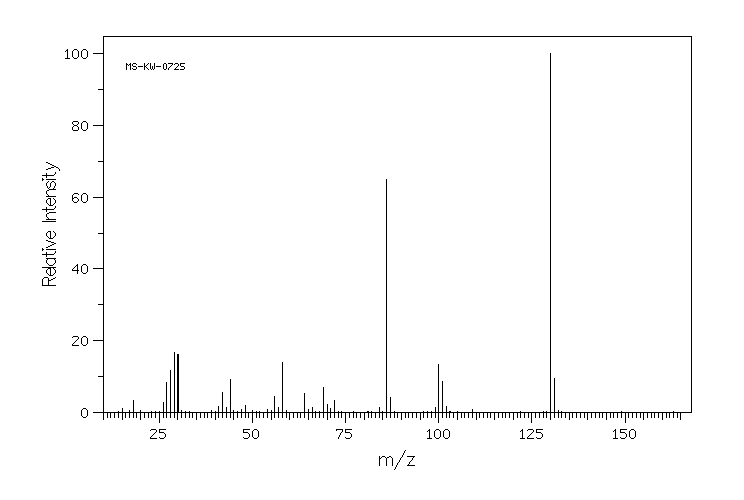三氟甲基磺酸四乙基铵 | 35895-69-3
中文名称
三氟甲基磺酸四乙基铵
中文别名
三氟甲基磺酸四乙铵;四乙铵三氟甲磺酸
英文名称
tetraethylammonium trifluoromethanesulfonate
英文别名
tetraethylammonium triflate;tetraethylammonium trifluoromethanesulphonate;tetraethylazanium;trifluoromethanesulfonate
CAS
35895-69-3
化学式
CF3O3S*C8H20N
mdl
——
分子量
279.324
InChiKey
PUZYNDBTWXJXKN-UHFFFAOYSA-M
BEILSTEIN
——
EINECS
——
-
物化性质
-
计算性质
-
ADMET
-
安全信息
-
SDS
-
制备方法与用途
-
上下游信息
-
文献信息
-
表征谱图
-
同类化合物
-
相关功能分类
-
相关结构分类
物化性质
-
熔点:161-163 °C
-
溶解度:在乙腈中的溶解度:0.1 g/mL,澄清,无色
计算性质
-
辛醇/水分配系数(LogP):1.93
-
重原子数:17
-
可旋转键数:4
-
环数:0.0
-
sp3杂化的碳原子比例:1.0
-
拓扑面积:65.6
-
氢给体数:0
-
氢受体数:6
安全信息
-
危险品标志:Xi,C
-
安全说明:S26,S36
-
危险类别码:R36/37/38
-
WGK Germany:3
-
海关编码:2923900090
-
危险性防范说明:P264,P280,P302+P352+P332+P313+P362+P364,P305+P351+P338+P337+P313
-
危险性描述:H315,H319
-
储存条件:存放于惰性气体中,并避免接触湿气(防止吸湿)。
SDS
三氟甲基磺酸四乙铵 修改号码:5
模块 1. 化学品
产品名称: Tetraethylammonium Trifluoromethanesulfonate
修改号码: 5
模块 2. 危险性概述
GHS分类
物理性危害 未分类
健康危害
皮肤腐蚀/刺激 第2级
严重损伤/刺激眼睛 2A类
环境危害 未分类
GHS标签元素
图标或危害标志
信号词 警告
危险描述 造成皮肤刺激
造成严重眼刺激
防范说明
[预防] 处理后要彻底清洗双手。
穿戴防护手套/护目镜/防护面具。
[急救措施] 眼睛接触:用水小心清洗几分钟。如果方便,易操作,摘除隐形眼镜。继续冲洗。
眼睛接触:求医/就诊
皮肤接触:用大量肥皂和水轻轻洗。
若皮肤刺激:求医/就诊。
脱掉被污染的衣物,清洗后方可重新使用。
模块 3. 成分/组成信息
单一物质/混和物 单一物质
化学名(中文名): 三氟甲基磺酸四乙铵
百分比: >99.0%(T)
CAS编码: 35895-69-3
俗名: Tetraethylammonium Triflate
三氟甲基磺酸四乙铵 修改号码:5
模块 3. 成分/组成信息
分子式: C9H20F3NO3S
模块 4. 急救措施
吸入: 将受害者移到新鲜空气处,保持呼吸通畅,休息。若感不适请求医/就诊。
皮肤接触: 立即去除/脱掉所有被污染的衣物。用大量肥皂和水轻轻洗。
若皮肤刺激或发生皮疹:求医/就诊。
眼睛接触: 用水小心清洗几分钟。如果方便,易操作,摘除隐形眼镜。继续清洗。
如果眼睛刺激:求医/就诊。
食入: 若感不适,求医/就诊。漱口。
紧急救助者的防护: 救援者需要穿戴个人防护用品,比如橡胶手套和气密性护目镜。
模块 5. 消防措施
合适的灭火剂: 干粉,泡沫,雾状水,二氧化碳
特殊危险性: 小心,燃烧或高温下可能分解产生毒烟。
特定方法: 从上风处灭火,根据周围环境选择合适的灭火方法。
非相关人员应该撤离至安全地方。
周围一旦着火:如果安全,移去可移动容器。
消防员的特殊防护用具: 灭火时,一定要穿戴个人防护用品。
模块 6. 泄漏应急处理
个人防护措施,防护用具, 使用个人防护用品。远离溢出物/泄露处并处在上风处。
紧急措施: 泄露区应该用安全带等圈起来,控制非相关人员进入。
环保措施: 防止进入下水道。
控制和清洗的方法和材料: 清扫收集粉尘,封入密闭容器。注意切勿分散。附着物或收集物应该立即根据合适的
法律法规处置。
模块 7. 操作处置与储存
处理
技术措施: 在通风良好处进行处理。穿戴合适的防护用具。防止粉尘扩散。处理后彻底清洗双手
和脸。
注意事项: 如果粉尘或浮质产生,使用局部排气。
操作处置注意事项: 避免接触皮肤、眼睛和衣物。
贮存
储存条件: 保持容器密闭。存放于凉爽、阴暗处。
存放于惰性气体环境中。
防湿。
远离不相容的材料比如氧化剂存放。
易湿
包装材料: 依据法律。
模块 8. 接触控制和个体防护
工程控制: 尽可能安装封闭体系或局部排风系统,操作人员切勿直接接触。同时安装淋浴器和洗
眼器。
个人防护用品
呼吸系统防护: 防尘面具。依据当地和政府法规。
手部防护: 防护手套。
眼睛防护: 安全防护镜。如果情况需要,佩戴面具。
皮肤和身体防护: 防护服。如果情况需要,穿戴防护靴。
三氟甲基磺酸四乙铵 修改号码:5
模块 9. 理化特性
固体
外形(20°C):
外观: 晶体-粉末
颜色: 白色类白色
气味: 无资料
pH: 无数据资料
熔点: 160°C
沸点/沸程 无资料
闪点: 无资料
爆炸特性
爆炸下限: 无资料
爆炸上限: 无资料
密度: 无资料
溶解度:
[水] 无资料
[其他溶剂] 无资料
模块 10. 稳定性和反应性
化学稳定性: 一般情况下稳定。
危险反应的可能性: 未报道特殊反应性。
须避免接触的物质 氧化剂
危险的分解产物: 一氧化碳, 二氧化碳, 氮氧化物 (NOx), 氟化氢, 硫氧化物
模块 11. 毒理学信息
急性毒性: 无资料
对皮肤腐蚀或刺激: 无资料
对眼睛严重损害或刺激: 无资料
生殖细胞变异原性: 无资料
致癌性:
IARC = 无资料
NTP = 无资料
生殖毒性: 无资料
模块 12. 生态学信息
生态毒性:
鱼类: 无资料
甲壳类: 无资料
藻类: 无资料
残留性 / 降解性: 无资料
潜在生物累积 (BCF): 无资料
土壤中移动性
log水分配系数: 无资料
土壤吸收系数 (Koc): 无资料
亨利定律 无资料
constaNT(PaM3/mol):
模块 13. 废弃处置
如果可能,回收处理。请咨询当地管理部门。建议在可燃溶剂中溶解混合,在装有后燃和洗涤装置的化学焚烧炉中
焚烧。废弃处置时请遵守国家、地区和当地的所有法规。
三氟甲基磺酸四乙铵 修改号码:5
模块 14. 运输信息
联合国分类: 与联合国分类标准不一致
UN编号: 未列明
模块 15. 法规信息
《危险化学品安全管理条例》(2002年1月26日国务院发布,2011年2月16日修订): 针对危险化学品的安全使用、
生产、储存、运输、装卸等方面均作了相应的规定。
模块16 - 其他信息
N/A
模块 1. 化学品
产品名称: Tetraethylammonium Trifluoromethanesulfonate
修改号码: 5
模块 2. 危险性概述
GHS分类
物理性危害 未分类
健康危害
皮肤腐蚀/刺激 第2级
严重损伤/刺激眼睛 2A类
环境危害 未分类
GHS标签元素
图标或危害标志
信号词 警告
危险描述 造成皮肤刺激
造成严重眼刺激
防范说明
[预防] 处理后要彻底清洗双手。
穿戴防护手套/护目镜/防护面具。
[急救措施] 眼睛接触:用水小心清洗几分钟。如果方便,易操作,摘除隐形眼镜。继续冲洗。
眼睛接触:求医/就诊
皮肤接触:用大量肥皂和水轻轻洗。
若皮肤刺激:求医/就诊。
脱掉被污染的衣物,清洗后方可重新使用。
模块 3. 成分/组成信息
单一物质/混和物 单一物质
化学名(中文名): 三氟甲基磺酸四乙铵
百分比: >99.0%(T)
CAS编码: 35895-69-3
俗名: Tetraethylammonium Triflate
三氟甲基磺酸四乙铵 修改号码:5
模块 3. 成分/组成信息
分子式: C9H20F3NO3S
模块 4. 急救措施
吸入: 将受害者移到新鲜空气处,保持呼吸通畅,休息。若感不适请求医/就诊。
皮肤接触: 立即去除/脱掉所有被污染的衣物。用大量肥皂和水轻轻洗。
若皮肤刺激或发生皮疹:求医/就诊。
眼睛接触: 用水小心清洗几分钟。如果方便,易操作,摘除隐形眼镜。继续清洗。
如果眼睛刺激:求医/就诊。
食入: 若感不适,求医/就诊。漱口。
紧急救助者的防护: 救援者需要穿戴个人防护用品,比如橡胶手套和气密性护目镜。
模块 5. 消防措施
合适的灭火剂: 干粉,泡沫,雾状水,二氧化碳
特殊危险性: 小心,燃烧或高温下可能分解产生毒烟。
特定方法: 从上风处灭火,根据周围环境选择合适的灭火方法。
非相关人员应该撤离至安全地方。
周围一旦着火:如果安全,移去可移动容器。
消防员的特殊防护用具: 灭火时,一定要穿戴个人防护用品。
模块 6. 泄漏应急处理
个人防护措施,防护用具, 使用个人防护用品。远离溢出物/泄露处并处在上风处。
紧急措施: 泄露区应该用安全带等圈起来,控制非相关人员进入。
环保措施: 防止进入下水道。
控制和清洗的方法和材料: 清扫收集粉尘,封入密闭容器。注意切勿分散。附着物或收集物应该立即根据合适的
法律法规处置。
模块 7. 操作处置与储存
处理
技术措施: 在通风良好处进行处理。穿戴合适的防护用具。防止粉尘扩散。处理后彻底清洗双手
和脸。
注意事项: 如果粉尘或浮质产生,使用局部排气。
操作处置注意事项: 避免接触皮肤、眼睛和衣物。
贮存
储存条件: 保持容器密闭。存放于凉爽、阴暗处。
存放于惰性气体环境中。
防湿。
远离不相容的材料比如氧化剂存放。
易湿
包装材料: 依据法律。
模块 8. 接触控制和个体防护
工程控制: 尽可能安装封闭体系或局部排风系统,操作人员切勿直接接触。同时安装淋浴器和洗
眼器。
个人防护用品
呼吸系统防护: 防尘面具。依据当地和政府法规。
手部防护: 防护手套。
眼睛防护: 安全防护镜。如果情况需要,佩戴面具。
皮肤和身体防护: 防护服。如果情况需要,穿戴防护靴。
三氟甲基磺酸四乙铵 修改号码:5
模块 9. 理化特性
固体
外形(20°C):
外观: 晶体-粉末
颜色: 白色类白色
气味: 无资料
pH: 无数据资料
熔点: 160°C
沸点/沸程 无资料
闪点: 无资料
爆炸特性
爆炸下限: 无资料
爆炸上限: 无资料
密度: 无资料
溶解度:
[水] 无资料
[其他溶剂] 无资料
模块 10. 稳定性和反应性
化学稳定性: 一般情况下稳定。
危险反应的可能性: 未报道特殊反应性。
须避免接触的物质 氧化剂
危险的分解产物: 一氧化碳, 二氧化碳, 氮氧化物 (NOx), 氟化氢, 硫氧化物
模块 11. 毒理学信息
急性毒性: 无资料
对皮肤腐蚀或刺激: 无资料
对眼睛严重损害或刺激: 无资料
生殖细胞变异原性: 无资料
致癌性:
IARC = 无资料
NTP = 无资料
生殖毒性: 无资料
模块 12. 生态学信息
生态毒性:
鱼类: 无资料
甲壳类: 无资料
藻类: 无资料
残留性 / 降解性: 无资料
潜在生物累积 (BCF): 无资料
土壤中移动性
log水分配系数: 无资料
土壤吸收系数 (Koc): 无资料
亨利定律 无资料
constaNT(PaM3/mol):
模块 13. 废弃处置
如果可能,回收处理。请咨询当地管理部门。建议在可燃溶剂中溶解混合,在装有后燃和洗涤装置的化学焚烧炉中
焚烧。废弃处置时请遵守国家、地区和当地的所有法规。
三氟甲基磺酸四乙铵 修改号码:5
模块 14. 运输信息
联合国分类: 与联合国分类标准不一致
UN编号: 未列明
模块 15. 法规信息
《危险化学品安全管理条例》(2002年1月26日国务院发布,2011年2月16日修订): 针对危险化学品的安全使用、
生产、储存、运输、装卸等方面均作了相应的规定。
模块16 - 其他信息
N/A
反应信息
-
作为反应物:参考文献:名称:酰胺基阴离子受体中的氟效应摘要:杂合受体设计成识别磺酸盐首基和全氟辛烷的氟尾部两者(CF 3(CF 2)7 SO 3 -,“PFOS”)通过偶合氟化羧酸在聚(氨基甲基)苯的支架制备。结合PFOS,CF 3 SO 3 - ,p -TsO -和Cl -通过监测1 H NMR和等温滴定量热法(ITC)。在氯仿溶剂中,氢键阴离子在酰胺N被伴随着低磁场位移ħ氟化受体的质子和热量的释放。1:1络合(K assoc)的缔合常数> 1000 M -1。类似的烃受体与阴离子客体的结合较弱(K assoc <50 M -1)。从头算计算表明,氟和非氟主体之间1:1结合强度的差异不能归因于N H供体酸度的差异。DOI:10.1021/jo9000788
-
作为产物:参考文献:名称:季铵盐类离子液体及其制备方法和应用摘要:本发明涉及一种季铵盐类离子液体,其化学结构式如下:其中,R为碳原子数为1~4的烷基,Y-为CF3SO3-或CF3CO2-,该季铵盐类离子液体在室温或接近室温的条件下完全由离子组成,电导率高、熔点低、电化学窗口宽、不挥发、不可燃、热稳定性好且不含有卤素杂质无毒,从而可以应用在制造高比容量的超级电容器或锂离子电池领域。此外,本发明还涉及该季铵盐类离子液体的制备方法及其应用。公开号:CN103833558B
-
作为试剂:描述:3-氨基苯硼酸 在 三氟甲基磺酸四乙基铵 、 Cu(2+)*4C11H9N*2ClO4(1-) 、 氢氟酸 作用下, 以 N,N-二甲基乙酰胺 、 正丁醇 为溶剂, 生成 3-[18F]fluoroaniline参考文献:名称:用于高效生产 18F 标记芳烃的下一代铜介体摘要:对一系列 Cu(II) 配合物的评估揭示了几种用于芳基硼和锡基底物放射性氟化的高效介质。在优化反应条件后,他们的应用能够制备七种 PET 示踪剂,提高放射化学产量和/或使用显着降低的前体负载。DOI:10.1002/chem.202202965
文献信息
-
Versatile Method for the Simultaneous Synthesis of Two Ionic Liquids, Otherwise Difficult to Obtain, with High Atom Economy作者:Andrea Szpecht、Adrian Zajac、Dawid Zielinski、Hieronim Maciejewski、Marcin SmiglakDOI:10.1002/open.201900217日期:2019.7has been proven. In the metathesis reactions that have been carried out, the halide anion was exchanged in ionic liquid with an alkyl sulfonate based anion using alkylating agents. The results obtained using ion chromatographic analysis on the newly synthesized compounds have been discussed. Also, the utilization of a gaseous methyl halide by‐product, obtained in the metathesis reaction and otherwise
-
A Family of Tri- and Dimetallic Pyridine Dicarboxamide Cryptates: Unusual <i>O</i>,<i>N</i>,<i>O</i>-Coordination and Facile Access to Secondary Coordination Sphere Hydrogen Bonding Interactions作者:Gary L. Guillet、Jesse B. Gordon、Gianna N. Di Francesco、Matthew W. Calkins、Erik Čižmár、Khalil A. Abboud、Mark W. Meisel、Ricardo García-Serres、Leslie J. MurrayDOI:10.1021/ic502873d日期:2015.3.16dimetallic metal complexes of pyridine dicarboxamide cryptates are reported in which changes to the base and metal source result in diverse structure types. Addition of strong bases, such as KH or KN(SiMe3)2, followed by divalent metal halides allows direct access to trinuclear complexes in which each metal center is coordinated by a dianionic N,N,N-chelate of each arm. These complexes bind a guest K+据报道,吡啶二甲酰胺隐窝的一系列三金属和二金属金属配合物,其中碱和金属来源的变化导致了多种结构类型。添加强碱,例如KH或KN(SiMe 3)2,然后添加二价金属卤化物,可以直接进入三核络合物,其中每个金属中心由每个臂的双阴离子N,N,N螯合物配位。这些络合物在三角平面配位环境中将客体K +阳离子结合在中心腔内。对三铁(II)和三毛精(II)配合物的合成中所用溶剂和碱的当量进行微小变化,即可得到两个具有非典型O的三核簇吡啶二甲酰胺臂上的、、N,O-配位;酰胺羰基O原子朝向腔体内部定向,以与每个金属中心配位。最后,改变碱基使得能够选择性合成其中一个吡啶二甲酰胺臂保持质子化的双核镍(II)和铜(II)配合物。这些酰胺质子在氢键网络的一端,该氢键网络延伸到整个内腔,并终止于与金属结合的氢氧化物,碳酸盐或碳酸氢盐供体。在dinickel复杂,碳酸氢盐不能被释放的CO 2热或在用N鼓泡2,这与以前报道
-
Gypsum board with a fluorine-containing antifungal agent申请人:Toreki William公开号:US20090104144A1公开(公告)日:2009-04-23A novel gypsum board having improved antifungal properties is disclosed. The board comprises a gypsum core, front and back paper facings, and a polymeric antifungal agent effective at inhibiting fungal growth. A preferred polymeric antifungal agent is polyDADMAC or polyTMMC. The novel gypsum board further comprises a non-polymeric antifungal agent comprising a fluorine-containing quaternary ammonium compound. Preferred non-polymeric ammonium compounds include Tetra-n-butylammonium fluoride and Tetraethylammonium fluoride. The polymeric antifungal agent can be present in the gypsum core and/or on one or both of the paper facings. The non-polymeric antifungal agent may be encapsulated in a material or ionically associated with the polymeric antifungal agent to allow releases of the non-polymeric antifungal agent over time and/or upon exposure to moisture. Methods for preparing the aforementioned novel gypsum board are also disclosed.
-
Switching the activity of a photoredox catalyst through reversible encapsulation and release作者:Giulio Bianchini、Alessandro Scarso、Giorgio La Sorella、Giorgio StrukulDOI:10.1039/c2cc37374b日期:——Reversible encapsulation of [Ru(bpy)(3)](2+) within a self-assembled hexameric resorcin[4]arene capsule turns off the photocatalytic aerobic oxidation of an aliphatic sulfide. Upon addition of a competitive cationic guest, the Ru(II) catalyst is released into solution where its catalytic activity is restored.
-
Solvated gold(I) in acetonitrile with inert counterions: a versatile starting material for gold(I) chemistry作者:Reinhard Kissner、Petr Latal、Gerhard GeierDOI:10.1039/c39930000136日期:——Solvated Au+ in acetonitrile with a variety of non-coordinating anions, an advantageous starting material for syntheses of gold(I) compounds, is conveniently prepared by halide-catalysed electrolysis.
表征谱图
-
氢谱1HNMR
-
质谱MS
-
碳谱13CNMR
-
红外IR
-
拉曼Raman
-
峰位数据
-
峰位匹配
-
表征信息
同类化合物
高烯丙基(甲磺酰基)胺
高炔丙基(甲磺酰基)胺
顺式-9-十八碳烯基甲烷磺酸酯
顺式-4-乙基环己基甲烷磺酸酯
顺-1,2-双(甲磺酰基氧基甲基)环己烷
阿坎酸杂质
阿坎酸
锌甲烷磺酸盐
铵磺酸甜菜碱-3
铵磺酸甜菜碱-2
铵磺酸甜菜碱-1
铬雾抑制剂
铁三(三氟甲基磺酰基)亚胺
钾3-(三羟基硅烷基)-1-丙烷磺酸酯
钾1,1,2,2,3,3,4,4-八氟丁烷-1-磺酸盐
钡二乙烷磺酸酯
钠3-氨基丙烷磺酸酯
钠3-氨基-3-氧代-丙烷-1-磺酸酯
钠3-(三羟基硅烷基)-1-丙烷磺酸酯
钠2-[2-[2-[2-[2-[2-[2-[2-[2-[2-(2-十八碳-9-烯氧基乙氧基)乙氧基]乙氧基]乙氧基]乙氧基]乙氧基]乙氧基]乙氧基]乙氧基]乙氧基]-2-氧代-乙烷磺酸酯
钠1-羟基-1-庚烷磺酸酯
钠(1E)-1-十二碳烯-1-磺酸酯
酪朊酸钠
辛烷-1-磺酸甲酯
辛烷-1-磺酸乙酯
辛基-1-磺酸戊酯
辛-2-烯-1-磺酸
辅酶 M
西尼必利杂质7
萘-1,8-二甲醇
英丙舒凡对甲苯磺酸盐
英丙舒凡
苯基硒基三氟甲烷磺酸酯
芥酸酰胺丙基羟基磺基甜菜碱
艾日布林中间体
脒基牛磺酸
胺磺酸甜菜碱-4
联硫亚盐氯乙醛钠水合物
羧基-五聚乙二醇-磺酸
羟甲基磺酸钠
羟基甲烷磺酸铵盐
羟基甲烷磺酸钾
羟基甲氧基甲醇甲磺酸酯
羟乙磺酸钾
羟乙基磺酸铵盐
羟乙基磺酸钠
羟丙基硫代硫酸钠
美司那
磺酸钠
磺酸己烷









